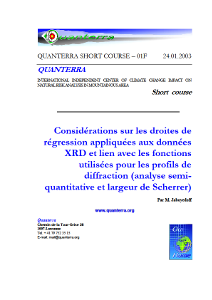Earth Sciences through Mathematics Physics Chemistry
Earth Sciences depends more and more on physics, mathematics and chemistry theory and related methods. Because modelling of natural processes needs quantification, as well as method to interpolate spatially and in time data between measurement points.
Part of the research will be to focus research on fundamental processes (physical and chemical) that create condition for high erosion rates and catastrophic events:
- Weathering
- Granular material physics
- Material rupture
- Etc…
Short Courses
 |
Régression appliquées aux données XRD et lien avec les fonctions utilisées pour les profils de diffraction (analyse semi-quantitative et largeur de Scherrer). 36p. Contenu: Pour bien comprendre ce qu’est une erreur, il faut d’abord avoir en tête que nous n’avons généralement accès qu’à l’estimation de paramètres statistiques (essentiellement la moyenne et la variance), qui, à l’aide d’un modèle connu, à priori, permettent d’établir la confiance qu’on peut apporter aux résultats. On suppose donc toujours que plus le nombre “d’expériences” est grand, plus l’estimation de paramètres statistiques s’améliore. Un estimateur ne prend pas nécessairement la même forme que son expression théorique. Il est important de tester la “viabilité” du modèle sur les données à tester. Par confiance on entend la probabilité qu’une mesure appartienne à l’intervalle défini par l’erreur. |
Key publications
-
Modèles thermiques simples de la croûte terrestre: un regard sur les Alpes
Jaboyedoff M. (1999), Soc. Vd. Sc. Nat. 86, 229-271. (www.unil.ch/svsn/)
Abstract: When studying a regional metamorphic history, the order of magnitude must be known in order to achieve a realistic model of rock Pressure (depth) – Temperature -time evolution (P-T-t). In other words, the necessary time and depth for a rock to reach a given temperature must be calculated. The first part of this paper is dedicated to the simplest analytical solution of the heat conduction equations applied to geology. The order of magnitude of conductivity, diffusivity etc. are also presented. Simple models demonstrate the importance of the exhumation processes and radioactive heat production.
The exhumation rate of hot rocks involved in a collision chain like the Alps deeply affects the initial thermal state of a collision chain. 1D finite difference simulation is compatible with the P-T-t path of the Alps. Nevertheless, the heat flow density of the Alps is low compared to the one expected. This implies a convincing cooling of the chain by water circulation induced by high hydraulic head.
